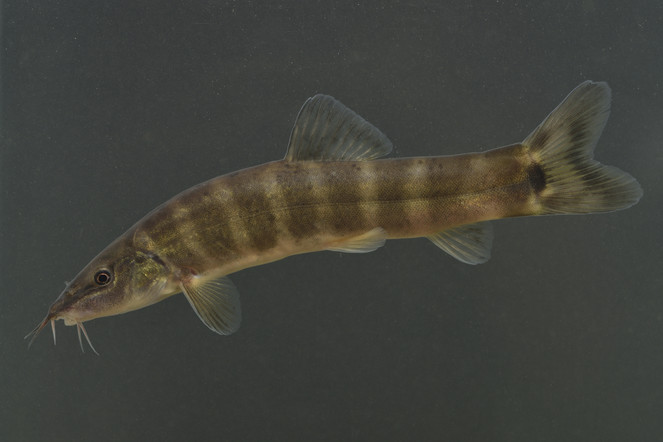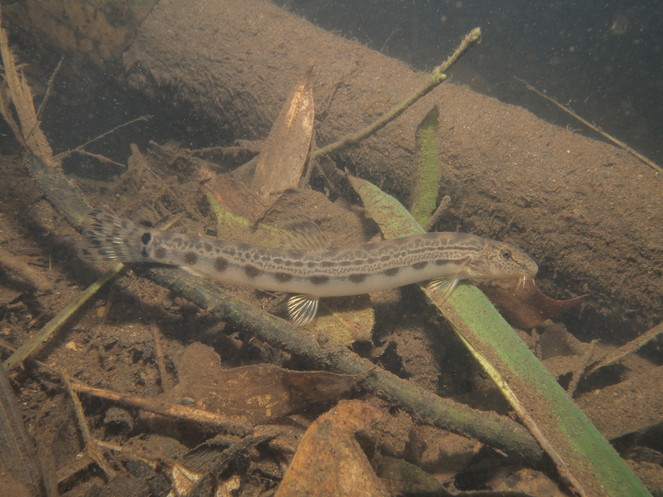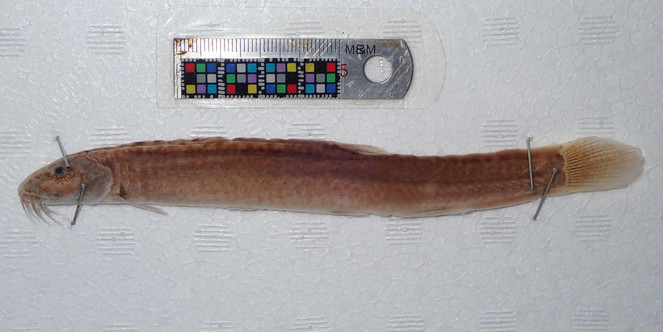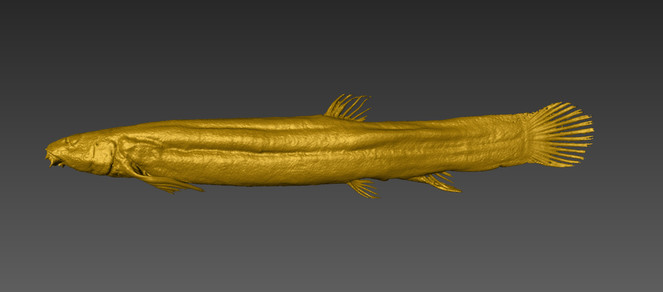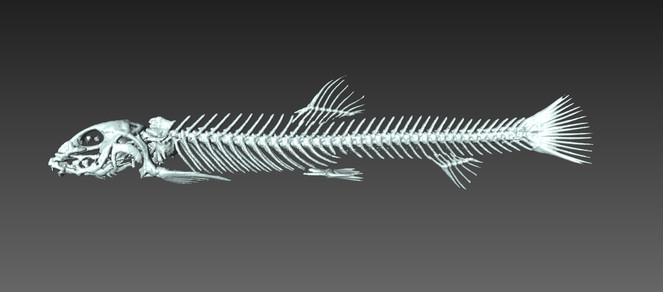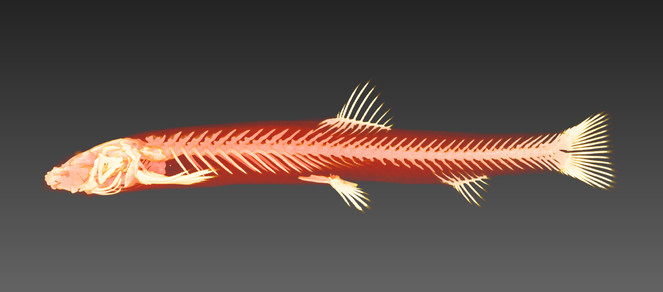|
Biodiversity Data Journal : Data Paper (Biosciences)
|
|
Corresponding author: Yuichi Kano (kano@species.jp)
Academic editor: Yasen Mutafchiev
Received: 29 Apr 2018 | Accepted: 11 Jun 2018 | Published: 06 Jul 2018
© 2018 Yuichi Kano, Jun Nakajima, Takeshi Yamasaki, Jyun-ichi Kitamura, Ryoichi Tabata
This is an open access article distributed under the terms of the Creative Commons Attribution License (CC BY 4.0), which permits unrestricted use, distribution, and reproduction in any medium, provided the original author and source are credited.
Citation: Kano Y, Nakajima J, Yamasaki T, Kitamura J, Tabata R () Photo images, 3D models and CT scanned data of loaches (Botiidae, Cobitidae and Nemacheilidae) of Japan. . https://doi.org/
|
|
Abstract
Background
Loach is one of the major cypriniform fishes in freshwater habitats of Japan; 35 taxa/clades have, until now, been recognised. Parallel to genetic studies, morphological examinations are needed for further development of loach study, eventually ichthyology and fish biology. Digital archiving, concerning taxonomy, ecology, ethology etc., is one of the progressive challenges for the open science of biology. This paper aimed to online publish photo images, 3D models and CT scanned data of all the known clades of loaches inhabiting Japan (103 individuals in total with several type specimens), contributing to ichthyology and public interest of biodiversity/biology.
New information
Photo images, 3D models and CT scanned data of all the known 35 taxa/clades of loaches inhabiting in Japan were online published at http://ffish.asia/loachesOfJapan and http://ffish.asia/loachesOfJapan3D.
Keywords
3D model; Anatomy; Bone; CT scan; Digital archiving; Fish specimen; Freshwater fishes of Japan; GBIF; Holotype; Loach; Morphology; Open science; Paratype; Skeleton; Undescribed species
Introduction
Loach is one of the major cypriniform fishes in freshwater habitats of Japan, being recognised with 23 described species/subspecies and 12 undescribed/undecided clades (
General description
This research aims to
1) list all the known taxa/clades of loaches inhabiting Japan with photo images (http://ffish.asia/loachesOfJapan) and
2) digitalise the specimens of each taxa/clades by 3D models and CT scanning (http://ffish.asia/loachesOfJapan3D).
The dataset was also registered on GBIF (http://ipt.pensoft.net/resource?r=jp_loaches_3dct_models)
Sampling methods
Photo images and specimens of loaches of Japan were taken in the field and borrowed from museums (see "Collection data").
The specimens were generally captured by a hand-net in the field. All the specimens were fixed in 10% formalin and preserved in 70% ethanol.
Photo images were taken in the field by capturing individuals (Fig.
A photo image of an individual of Parabotia curtus in a makeshift aquarium at a wild habitat.
A photo image of Cobitis sakahoko in the wild, under cloudy water by volcanic ash of Mt. Kirishima.
An old specimen of Misgurnus anguillicaudatus (Jindai-dojyô) (MPMQ-JJ1), an uncertain local clade that is already extinct.
A 3D model of the surface of Misgurnus anguillicaudatus (Clade B1) (JNC342).
A 3D skeletal model of a paratype of Cobitis striata fuchigamii (MPM-Fi1501).
CT scanned data of Barbatula oreas (JNC256).
A movie for CT scanned data of Cobitis minamorii yodoensis (OMNH-P45848), changing the camera angle and CT value.
Geographic coverage
Inland water habitats of Japan.
23 and 46 Latitude; 150 and 123 Longitude.
Taxonomic coverage
This paper includes all the known 35 loach taxa/clades (103 specimens) in Japan, of which 12 clades have still been undescribed or are uncertain.
Type specimens: The dataset includes nine type specimens as below.
Holotype: MPM-Fi1507 (Cobitis minamorii tokaiensis).
Paratypes: MPM-Fi1501 (Cobitis striata fuchigamii); MPM-Fi1502 (Cobitis striata hakataensis); MPM-Fi1503 (Cobitis kaibarai); MPM-Fi1504 (Cobitis magnostriata); MPM-Fi1505 (Cobitis minamorii minamorii); MPM-Fi1506 (Cobitis minamorii oumiensis); MPM-Fi1508 (Cobitis minamorii tokaiensis); MPM-Fi1509 (Cobitis minamorii saninensis).
Undescribed/uncertain clades: Below, we interpret the 12 undescribed/uncertain clades.
Twenty taxa of genus Cobitis have been hitherto known in Japan (
The situation about "Misgurnus anguillicaudatus" is rather complicated. Six taxa/clades of Misgurnus anguillicaudatus species complex has been hitherto known in Japan, namely "A", "B1", "B2", "Jindai", "IR" and "OK". Misgurnus sp. (Clade A) is a native loach clade of Japan, although the distribution is limited to northern parts such as Hokkaido and eastern Honshu (
Two Lefua species have still been left undescribed. Lefua sp. 1 is distributed amongst a narrow range of western Honshu, eastern Shikoku, Awaji Island and Shodo Island (
Non-native to Japan:
Misgurnus anguillicaudatus (Clade B2): Definite native range of M. anguillicaudatus (Clade B2) is still unclear, but it potentially inhabits China (
Misgurnus dabryanus: Native to China (
Lefua costata: Native to northern China (
IUCN rank and extinction: Japanese loaches are generally faced with extinction and a part of them are listed in the IUCN Red List. Two loaches have been unconfirmed for the last 20 years indicating extinction.
CR: Parabotia curtus
LC: "Misgurnus anguillicaudatus" that potentially includes Misgurnus sp. (Clade A), M. anguillicaudatus (Clade B1), M. anguillicaudatus (Clade B2), M. anguillicaudatus (Jindai), Misgurnus sp. IR and Misgurnus sp. OK.
Assumed to be extinct: Cobitis minamorii yodoensis; Misgurnus anguillicaudatus (Jindai).
| Rank | Scientific Name | Common Name |
|---|---|---|
| kingdom | Animalia | Animals |
| phylum | Chordata | Chordates |
| subphylum | Craniata | Vertebrates and hagfishes |
| class | Osteichthyes | Bony fishes and tetrapods |
| subclass | Actinopterygii | Ray-finned fishes |
| order | Cypriniformes | Carps, loaches, minnows and relatives |
| family | Botiidae | Botiid loach |
| species | Parabotia curtus | "Ayumodoki" |
| family | Cobitidae | True loaches |
| species | Cobitis kaibarai | "Ariake-suji-shima-dojyô" |
| species | Cobitis magnostriata | "Oogata-suji-shima-dojyô" |
| species | Cobitis matsubarae | "Yamato-shima-dojyô" |
| species | Cobitis sp. "yamato" complex Type A | "Yamato-shima-dojyô" (Type A) |
| subspecies | Cobitis minamorii minamorii | "San'yô-kogata-suji-shima-dojyô" |
| subspecies | Cobitis minamorii oumiensis | "Biwa-kogata-suji-shima-dojyô" |
| subspecies | Cobitis minamorii saninensis | "San'in-kogata-suji-shima-dojyô" |
| subspecies | Cobitis minamorii tokaiensis | "Tôkai-kogata-suji-shima-dojyô" |
| subspecies | Cobitis minamorii yodoensis | "Yodo-kogata-suji-shima-dojyô" |
| species | Cobitis sakahoko | "Oyodo-shima-dojyô" |
| species | Cobitis shikokuensis | "Hina-ishi-dojyô" |
| species | Cobitis sp. BIWAE type A | "Oo-shima-dojyô" |
| species | Cobitis sp. BIWAE type B | "Nishi-shima-dojyô" |
| species | Cobitis sp. BIWAE type C | "Higashi-shima-dojyô" |
| species | Cobitis sp. BIWAE type D | "Tosa-shima-dojyô" |
| subspecies | Cobitis striata fuchigamii | "Onga-suji-shima-dojyô" |
| subspecies | Cobitis striata hakataensis | "Hakata-suji-shima-dojyô" |
| subspecies | Cobitis striata striata | "Chûgata-suji-shima-dojyô" |
| species | Cobitis takatsuensis | "Ishi-dojyô" |
| species | Cobitis takenoi | "Tango-suji-shima-dojyô" |
| species | Misgurnus sp. (Clade A) | "Kita-dojyô" |
| species | Misgurnus anguillicaudatus (Clade B1) | "Dojyô" (Japan clade) |
| species | Misgurnus anguillicaudatus (Clade B2) | "Dojyô" (China clade) |
| species | Misgurnus anguillicaudatus (Jindai) | "Jindai-dojyô" |
| species | Misgurnus sp. IR | "Shinobi-dojyô" |
| species | Misgurnus sp. OK | "Hyoumon-dojyô" |
| species | Misgurnus dabryanus | "Kara-dojyô" |
| species | Niwaella delicata | "Ajime-dojyô" |
| family | Nemacheilidae | Stone loaches |
| species | Barbatula oreas | "Fuku-dojyô" |
| species | Lefua costata | "Hime-dojyô" |
| species | Lefua echigonia | "Hotoke-dojyô" |
| species | Lefua nikkonis | "Ezo-hotoke-dojyô" |
| species | Lefua sp. 1 | "Nagare-hotoke-dojyô" |
| species | Lefua sp. 2 | "Tôkai-nagare-hotoke-dojyô" |
Temporal coverage
Several specimens have no temporal information.
Collection data
Usage rights
Data resources
All the 35 known clades of loaches inhabiting Japan are listed with photo images. Below, the main 6 columns are listed;
| Column label | Column description |
|---|---|
| Scientific name | Formal scientific name or tentative name |
| Taxon | Taxonomical hierarchy (order/family/genus) |
| Species image | Photo images of the species |
| N | Number of specimen/occurence data |
| Specimens/data distribution | Showing rough localities of the occurence on a map |
| Other information | Other information such as Japanese name |
Surface/skeletal 3D models and CT scanned data are available for all the clades (103 individuals). To render the CT dicom files as a visual 3D volume, several free software are available. Below, the main 12 columns are listed;
| Column label | Column description |
|---|---|
| Specimen/Data ID | ID for the specimen/occurence |
| Images | Downloadable images/files of photos, 3D models and CT scanned data |
| Species | Scientific name (or tentative name) of the specimen |
| Taxon | Taxonomical hierarchy (order/family/genus) |
| N | Number of the individual(s) |
| DNA information | DNA sequence data if available |
| Location | Description of the locality |
| Specimens/data distribution | Showing rough localities of the occurence on a map |
| Sample year/month/day | Temporal infomation of the sampling |
| Japanese name | Japanese name |
| English name | English name or roman phonetics for Japanese |
| Comment | Other infomation such as sex, holotype, paratype etc. |
GBIF registered occurrence data for the specimens. Below, the main 10 columns are listed;
| Column label | Column description |
|---|---|
| occurrenceID | Occurrence ID and URL |
| basisOfRecord | The specific nature of the data record |
| eventDate | The date-time or interval during which the specimen collected |
| scientificName | Scientific name (or tentative name) of the specimen |
| decimalLatitude | Rough value of decimal latitude |
| decimalLongitude | Rough value of decimal longtitude |
| verbatimLocality | Description of the locality |
| typeStatus | Noted if the specimen is holotype or paratype |
| sex | Discrimination of male or female, while some are unknown |
| vernacularName | Japanese name |
Acknowledgements
We deeply appreciate Dr. Akihisa Iwata for help in taking photographs of Parabotia curtus. We are grateful to Mr. Mike Skinner for English proofreading. We also thank The Kyoto University Museum, Kanagawa Prefectural Museum of Natural History, Osaka Museum of Natural History and Tokushima Prefectural Museum for renting/loaning the specimens. This paper also includes partial results of studies funded by JSPS KAKENHI Grant Number 18HP8029 and Ministry of Agriculture, Forestry and Fisheries of Japan (Research Project for Biodiversity Assessment and Conservation for Sustainable Agriculture).
Author contributions
Yuichi Kano (manuscript writing, photographs and database/data management), Jun Nakajima (manuscript writing, photographs, identification and specimens provision), Taksehi Yamasaki (CT scanning), Jyun-ichi Kitamura (specimens provision) and Ryoichi Tabata (specimens provision).
References
-
The digital fish library: Using MRI to digitize, database, and document the morphological diversity of fish.PLoS ONE7:e34499. https://doi.org/10.1371/journal.pone.0034499
-
中国花鳅亚科鱼类系统分类的研究 [A study on the classification of the subfamily Cobitinae of China].Transactions of the Chinese Ichtyological Society(1)21‑32. [InChinese].
-
原色韓國淡水魚圖鑑. [Coloured Illustrations of the Freshwater Fishes of Korea].1.Hyangmunsa,Seoul,278pp. [InKorean].
-
On the sexual dimorphism and the taxonomical status of some Japanese loaches.Zoological Magazine48:983‑994. [InJapanese with English abstract].
-
FishPix. http://fishpix.kahaku.go.jp/fishimage-e/index.html. Accessed on: 2018-2-19.
-
Population genetic structure, diversity and stocking effect of the oriental weatherloach (Misgurnus anguillicaudatus) in an isolated island.Environmental Biology of Fishes90:211‑222. https://doi.org/10.1007/s10641-010-9733-7
-
Critical status of the genetically-district, oriental weather loach (Misgurnus anguillicaudatus) population on Iriomote Island, Japan.Japanese Journal of Ichthyology59:37‑43. [InJapanese with English abstract]. https://doi.org/10.11369/jji.59.37
-
An online database on freshwater fish diversity and distribution in Mainland Southeast Asia.Ichthyological Research60:293‑295. https://doi.org/10.1007/s10228-013-0349-8
-
Non-killing simple photography techniques of small–middle freshwater fishes in the field.Japanese Journal of Ichthyology61:123‑125. [InJapanese].
-
A dataset of fishes in and around Inle Lake, an ancient lake of Myanmar, with DNA barcoding, photo images and CT/3D models.Biodiversity Data Journal4:e10539. https://doi.org/10.3897/BDJ.4.e10539
-
Population structure and local differentiation in the delicate loach, Niwaella delicata, as revealed by mitochondrial DNA and morphological analyses.Ichthyological Research48:127‑135. https://doi.org/10.1007/s10228-001-8127-4
-
Two genetically divergent groups in the Japanese spined loach, Cobitis takatsuensis, and their phylogenetic relationships among Japanese cobitis inferred from mitochondrial DNA analyses.Zoological Science18:249‑259. https://doi.org/10.2108/zsj.18.249
-
Genetic structure of a Japanese allotetraploid loach of the genus Cobitis (Osteichthyes, Cobitidae).Folia Biologica51 Suppl:93‑100.
-
Phylogeography and the maternal origin of the tetraploid form of the Japanese spined loach, Cobitis biwae, revealed by mitochondrial DNA analysis.Ichthyological Research50:318‑325. https://doi.org/10.1007/s10228-003-0174-6
-
Genetic relationships among the Japanese and Korean striated spined loach complex (Cobitidae: Cobitis) and their phylogenetic positions.Ichthyological Research52:111‑122. https://doi.org/10.1007/s10228-004-0261-3
-
台灣淡水魚蝦生態大圖鑑. [A field guide to freshwater fishes and shrimps in Taiwan].7,1.Global Views – Commonwealth Publishing Group,Taipei,240pp. [InChinese]. [ISBN978-986-417-888-9]
-
Phylogeography of Loaches of the Genus Lefua (Balitoridae, Cypriniformes) Inferred from Mitochondrial DNA Sequences.Zoological Science22(2):157‑168. https://doi.org/10.2108/zsj.22.157
-
Parallel evolution in eight-barbel loaches of the genus Lefua (Balitoridae, Cypriniformes) revealed by mitochondrial and nuclear DNA phylogenies.Molecular Phylogenetics and Evolution60(3):416‑427. https://doi.org/10.1016/j.ympev.2011.05.005
-
A new species of cobitid fish from Japan (Cobitis takatsuensis).Memoirs of the Ehime University. Section II, Natural Science (Series B (Biology))6:133‑143.
-
Cryptic clonal lineages and genetic diversity in the loach Misgurnus anguillicaudatus (Teleostei: Cobitidae) inferred from nuclear and mitochondrial DNA analyses.Genetica132:159‑171. https://doi.org/10.1007/s10709-007-9158-1
-
Taxonomic study of the Cobitis striata complex (Cypriniformes, Cobitidae) in Japan.Zootaxa3586:103‑130. URL: http://www.mapress.com/j/zt/article/view/14673
-
Proposal of standard Japanese names for Japanese loaches in the genus Cobitis (Cobitidae).Japanese Journal of Ichthyology59:86‑95. [InJapanese].
-
Cobitis takenoi sp. n. (Cypriniformes, Cobitidae): a new spined loach from Honshu Island, Japan.ZooKeys568:119‑128. https://doi.org/10.3897/zookeys.568.7733
-
Cobitis sakahoko, a new species of spined loach (Cypriniformes: Cobitidae) from southern Kyushu Island, Japan.Ichthyological Research63:68‑78. https://doi.org/10.1007/s10228-015-0476-5
-
日本のドジョウ. [Loaches of Japan].Yama-kei Publishers,Tokyo. [InJapanese with English description for each species/clade].
-
A revision of the Japanese striped loaches, referred to the genus Cobitis.Science Report of the Tokyo Bunrika Daigaku. Section B4:89‑104.
-
Extensive hybridization and tetrapolyploidy in spined loach fish.Molecular Phylogenetics and Evolution56:1001‑1010. https://doi.org/10.1016/j.ympev.2010.04.021
-
On the systematics and phylogeography of eight-barbel loaches of the genus Lefua (Cobitoidea: Nemacheilidae): mtDNA typing of L. pleskei.Russian Journal of Genetics44(7):817‑825. https://doi.org/10.1134/s1022795408070090
-
Morphological and genetic characteristics of misgurnid loach from Okinawa and Iriomote Islands.Bulletin of the Bio-geographical Society of Japan66:141‑153. [InJapanese with English abstract].
-
A new loach, Cobitis shikokuensis (Teleostei: Cobitidae), from Shikoku Island, Japan.Ichthyological Research53:315‑322. https://doi.org/10.1007/s10228-006-0352-4
-
Jindai-dojyo.Tansuigyo(4):115‑118. [InJapanese].
-
Species composition and distribution of the freshwater fish fauna of the North of Vietnam.Hydrobiologia121(3):281‑286. https://doi.org/10.1007/bf00017548
